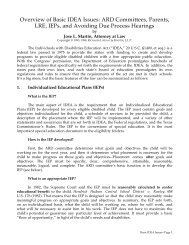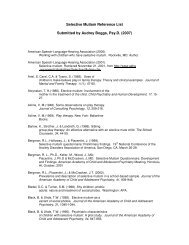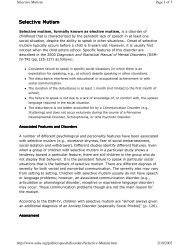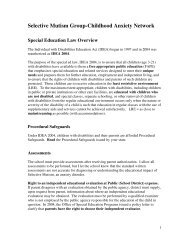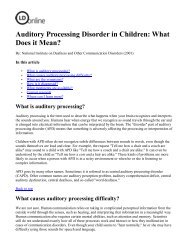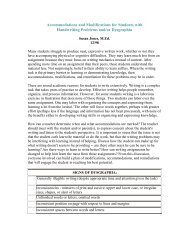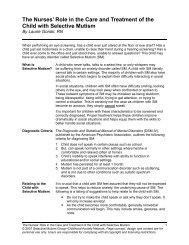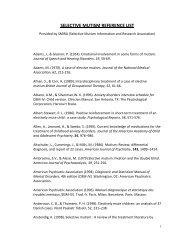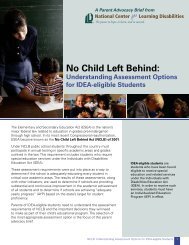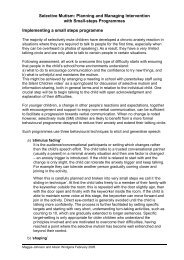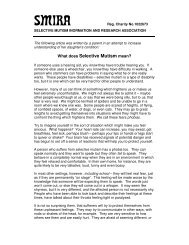The Older Child or Teen with Selective Mutism By Ricki Blau
The Older Child or Teen with Selective Mutism By Ricki Blau
The Older Child or Teen with Selective Mutism By Ricki Blau
- No tags were found...
Create successful ePaper yourself
Turn your PDF publications into a flip-book with our unique Google optimized e-Paper software.
DRAFT 9/20/05<strong>The</strong> <strong>Older</strong> <strong>Child</strong> <strong>or</strong> <strong>Teen</strong> <strong>with</strong> <strong>Selective</strong> <strong>Mutism</strong><strong>By</strong> <strong>Ricki</strong> <strong>Blau</strong><strong>Selective</strong> <strong>Mutism</strong> in the <strong>Older</strong> <strong>Child</strong><strong>Selective</strong> <strong>Mutism</strong> (SM) is usually noticed when a child begins pre-school <strong>or</strong>kindergarten, if not bef<strong>or</strong>e. So when a student in the upper elementary <strong>or</strong>secondary grades has SM, it’s safe to assume that he <strong>or</strong> she has been living <strong>with</strong><strong>Selective</strong> <strong>Mutism</strong> f<strong>or</strong> many years. Within the lifetime of today’s teens,researchers and treating professionals have learned much about this anxietycondition. Young children who receive prompt and appropriate treatment nowmake great strides. But inf<strong>or</strong>mation about SM is still not as widely available as itshould be—educat<strong>or</strong>s, doct<strong>or</strong>s, and psychologists often fail to recognize SM <strong>or</strong>understand how to help affected children. Consequently, many children do notreceive early diagnosis <strong>or</strong> appropriate supp<strong>or</strong>t.<strong>Older</strong> students <strong>with</strong> SM may have received no treatment <strong>or</strong> may have sufferedyears of inappropriate treatment and negative reinf<strong>or</strong>cement. Instead of beinghelped to control their anxiety and become m<strong>or</strong>e comf<strong>or</strong>table at school, they mayhave been pressured to do the things they feared, such as speaking. Over theyears they have developed ingrained behavi<strong>or</strong> patterns and maladaptive copingmechanisms by which they avoid situations that make them anxious. Notspeaking has become a habit that is difficult to break. <strong>The</strong>y begin to seethemselves as “the child who doesn’t speak” as do many people around them.<strong>The</strong> fear of receiving attention if they should start to speak makes it harder toimagine changing. <strong>The</strong>y may also have developed phobias about speaking <strong>or</strong>having their voice heard. <strong>Older</strong> children <strong>with</strong> SM often lag behind their age peersin social competence because they’ve had less experience <strong>with</strong> peers and adults.Treatment plans f<strong>or</strong> the older child must take these complications into account.Students <strong>with</strong> SM are, in general, extremely sensitive individuals. <strong>Older</strong> childrenand teens are acutely aware of their differences and the responses they elicit fromtheir teachers and other adults. People have been trying to get them to talk f<strong>or</strong>years! <strong>The</strong>y understand that they repeatedly fail to meet standard expectationsin the school setting. Consequently, they are wary and keenly aware of the mostsubtle pressure to communicate. Wanting to avoid attention, they typically havelearned to hide the appearance of anxiety; while younger children may freezeand show a blank expression, older students m<strong>or</strong>e commonly appear relaxed and“ok,” even when they’re not. In summary, older children have developed m<strong>or</strong>ecomplicated profiles, influenced by their experiences and environmentalstress<strong>or</strong>s. <strong>The</strong>ir individual profiles tend to show m<strong>or</strong>e variation than <strong>with</strong>younger children, and treatment needs to be tail<strong>or</strong>ed to the individual.DRAFTComments to: <strong>Ricki</strong> <strong>Blau</strong>, ricki@pixar.com
DRAFT 9/20/05Helping the Student Make ProgressF<strong>or</strong> all of the above reasons, you can expect progress to be m<strong>or</strong>e difficult andslow once a child has reached the age of eight <strong>or</strong> nine. Different strategies andinterventions are needed f<strong>or</strong> older children <strong>or</strong> teens. Consider, f<strong>or</strong> instance, afading strategy, in which a child first talks <strong>with</strong> a parent in a private room atschool, and over time other individuals are gradually drawn into theconversational group. This often succeeds <strong>with</strong> a very young child. <strong>Older</strong>children, on the other hand, have developed a self-image as a non-communicat<strong>or</strong>and would recognize the situation as a set up aimed at getting them to talk. <strong>The</strong>fading strategy doesn’t w<strong>or</strong>k f<strong>or</strong> them. As experienced treating professionalshave found, the older child <strong>or</strong> teen needs to be actively involved and in control oftheir therapy, which aims to help them recognize their anxiety and take small,controlled steps in real life situations. In younger children, medication to reducethe anxiety often produces quick and dramatic results. With older students, whohave many habits to unlearn, medication is often an imp<strong>or</strong>tant adjunct tobehavi<strong>or</strong>al therapy but is not very effective on its own.F<strong>or</strong> older children, the thought of changing longstanding habits and exposingthemselves to anxiety-provoking situations is frightening, and they can becomequite resistant to therapy. Dr. Elisa Shipon-Blum, the Medical Direct<strong>or</strong> of the<strong>Selective</strong> <strong>Mutism</strong> Group/<strong>Child</strong>hood Anxiety Netw<strong>or</strong>k, has observed that if achild is not verbal in school by the age of eight <strong>or</strong> nine, he <strong>or</strong> she is unlikely totalk at school until at least high school. F<strong>or</strong> students in this age range, the focusmust be on helping the student realize his <strong>or</strong> her academic potential and remainsocially connected. This will usually require flexibility about assessment andparticipation.If teachers can help decrease anxiety at school and increase the student’s selfconfidence,there will be a greater chance of progressing communicatively.Perhaps the student will interact <strong>with</strong> new w<strong>or</strong>k partners, carry notes to theoffice <strong>with</strong>out a friend, <strong>or</strong> respond m<strong>or</strong>e easily to discussion questions. It isimp<strong>or</strong>tant to recognize even small improvements and not become discouraged!Measure success by how well the student functions at school in general, and notby his <strong>or</strong> her communicative relationship <strong>with</strong> the teacher. Even the mostempathetic and skilled teacher is an auth<strong>or</strong>ity figure, and SM students arecommonly m<strong>or</strong>e inhibited <strong>with</strong> teacher than <strong>with</strong> other people. At the beginningof a new school year, new teachers should start allow f<strong>or</strong> plenty of “warm-up”time. Start slowly <strong>with</strong> the goals of getting to know the student, gaining theirtrust, and helping the student become as comf<strong>or</strong>table as possible at school.Emphasizing <strong>or</strong> pushing f<strong>or</strong> communication in any f<strong>or</strong>m, non-verbal, written, <strong>or</strong><strong>or</strong>al, is likely to cause the student to <strong>with</strong>draw. Communication will develop asthe student becomes less anxious.DRAFTComments to: <strong>Ricki</strong> <strong>Blau</strong>, ricki@pixar.com
DRAFT 9/20/05Helping the student make and maintain social ties is vital. It is, unf<strong>or</strong>tunately,too easy f<strong>or</strong> a socially anxious individual to become isolated and depressed.Depression is m<strong>or</strong>e likely as a child enters adolescence and can lead to m<strong>or</strong>esevere anxiety, social isolation, lower perf<strong>or</strong>mance in school, suicidal thoughts,and self-medication <strong>with</strong> alcohol <strong>or</strong> drugs.It’s M<strong>or</strong>e than Not TalkingStudies have shown that over 90% of children <strong>with</strong> SM have Social AnxietyDis<strong>or</strong>der, also known as Social Phobia. In fact, some experts have suggestedthat SM may simply be a manifestation <strong>or</strong> variant of social anxiety. <strong>The</strong>sechildren are excessively self-conscious. <strong>The</strong>y are afraid of being embarrassed,being judged <strong>or</strong> criticized, and of receiving scrutiny <strong>or</strong> attention. Social anxietydoes not make a child anti-social <strong>or</strong> even asocial. A socially anxious child can bevery social and enjoy the company of family and friends when in a familiar andcomf<strong>or</strong>table setting. Some students may be m<strong>or</strong>e comf<strong>or</strong>table <strong>with</strong> their peers(this is most common), but others may be m<strong>or</strong>e comf<strong>or</strong>table <strong>with</strong> a trusted adult.<strong>The</strong> student’s self-consciousness usually extends to situations beyond speakingand commonly affects non-verbal as well as verbal communication. In general,the student <strong>with</strong> SM finds it much easier to respond to another individual than toinitiate communication. A student who is able to respond to a teacher’s question,(verbally, in writing, <strong>or</strong> <strong>with</strong> a gesture) may be unable to initiate <strong>with</strong> that sameteacher to ask a question <strong>or</strong> contribute to a class discussion. He <strong>or</strong> she may beunable to take a note to the attendance office, check out a library book, <strong>or</strong> make apurchase at the snack bar. SM has an impact both academically and socially, andstudents can feel left out because of their inability to interact <strong>with</strong> ease.Some students, who may have partially overcome their SM, do speak at school.Most likely, these students still experience anxiety, even though it is less obvious.<strong>The</strong>y may not be able to speak in all situations <strong>or</strong> <strong>with</strong> all people. A student whois able to respond to a teacher’s question <strong>or</strong> even contribute to a discussion maybe completely unable to ask a question <strong>or</strong> express a concern.Anxiety can affect academic perf<strong>or</strong>mance in many ways, even in a student whobegins to talk at school. Not talking is only the tip of the iceberg! Othermanifestations of anxiety include:• Perfectionism; w<strong>or</strong>ry that w<strong>or</strong>k is inadequate in quality and/<strong>or</strong> quantity• Procrastination and avoidanceDRAFTComments to: <strong>Ricki</strong> <strong>Blau</strong>, ricki@pixar.com
DRAFT 9/20/05• Problems <strong>with</strong> test-taking and timed testing; may rush f<strong>or</strong> fear of notfinishing in time; may panic; may be too anxious to check answers <strong>or</strong> maycheck answers repeatedly and not finish• Problems <strong>with</strong> open-ended <strong>or</strong> unclear assignments; w<strong>or</strong>ry that they don’tknow what the teacher wants <strong>or</strong> that they will do the wrong thing• Unable to ask f<strong>or</strong> help <strong>or</strong> clarification; unable to express w<strong>or</strong>ries <strong>or</strong>complaints• Afraid to express an opinion, even to express likes <strong>or</strong> dislikes• “Blanking,” <strong>or</strong> panic-like reactions• Easily frustrated• Illegible, tiny, <strong>or</strong> faint writing to obscure answers they’re unsure of• Difficulties <strong>with</strong> group w<strong>or</strong>k; may be unassertive <strong>or</strong> passive; conversely,may be a “control-freak” if w<strong>or</strong>ried that the group’s w<strong>or</strong>k is inadequate• School refusal <strong>or</strong> faked illness to avoid social situations at school <strong>or</strong>because of w<strong>or</strong>ries about schoolw<strong>or</strong>k<strong>The</strong> first step in helping a student <strong>with</strong> these academic difficulties is to recognizethat they are manifestations of anxiety. <strong>The</strong>n,• w<strong>or</strong>k to build the student’s self-esteem and self-confidence,• increase the student’s comf<strong>or</strong>t and reduce anxiety at school,• back off on all pressure to speak, and• make accommodations, such as those suggested in the following section,that allow the student to progress academically.Mild expressive language difficulties appear to be m<strong>or</strong>e common <strong>with</strong> SMstudents than among the general population, though they probably affect only amin<strong>or</strong>ity. This can be a source of added self-consciousness and anxiety. Subtleeffects on <strong>or</strong>al and written expression can include: w<strong>or</strong>d retrieval glitches, tersewriting <strong>with</strong> few descriptive details, and the use of non-specific language (e.g.“that thing” instead of a precise noun). A screening by a Speech and LanguagePathologist <strong>or</strong> Neuropsychologist may be appropriate if there are concerns aboutlanguage difficulties.DRAFTComments to: <strong>Ricki</strong> <strong>Blau</strong>, ricki@pixar.com
DRAFT 9/20/05Accommodations and Classroom StrategiesListed below are suggestions f<strong>or</strong> strategies and accommodations that may behelpful f<strong>or</strong> the older student <strong>with</strong> <strong>Selective</strong> <strong>Mutism</strong>. Accommodations andmodifications may be specified in an IEP <strong>or</strong> 504 Plan (in the US). Someaccommodations are appropriate f<strong>or</strong> almost any student <strong>with</strong> SM:• Training f<strong>or</strong> teacher(s) covering the nature of SM and classroom strategies;training bef<strong>or</strong>e the start of the school year followed by on-going supp<strong>or</strong>t• Brief training so that all adults who might have contact <strong>with</strong> the studentunderstand SM and how to interact <strong>with</strong> the student.• No grading down f<strong>or</strong> not speaking <strong>or</strong> f<strong>or</strong> any failure to communicate thatis due to the anxiety condition.• No pressure to speak. No teasing, threatening, limiting the student’sparticipation, <strong>or</strong> punishment f<strong>or</strong> any failure to participate that is related tothe anxiety condition.• Alternative f<strong>or</strong>ms of assessment and participation to substitute f<strong>or</strong>speaking, such as: written w<strong>or</strong>k, non-verbal communication, audio- <strong>or</strong>video-taping, collab<strong>or</strong>ation <strong>with</strong> friends, practice at home under parent’ssupervision, the use of a computer, <strong>or</strong> the use of another person as averbal intermediary. Individual w<strong>or</strong>k may be allowed f<strong>or</strong> a student whois unable to participate in a group.• Warm, flexible teachers who understand SM as an anxiety condition• Avoid singling out the student <strong>or</strong> calling attention to any differences.• Avoid calling attention to any new steps the student makes, such astalking in a new situation; other students should be told, <strong>with</strong>out the SMstudent present, to not comment if the SM student talks• No therapeutic interventions attempted except under the guidance of anauth<strong>or</strong>ized treating professional <strong>or</strong> as specified in the IEP <strong>or</strong> 504 Plan;written rec<strong>or</strong>d required of any attempted intervention.• In general, except as specified in the IEP, treat the student as much aspossible like any other student.Other accommodations and strategies to consider, depending on the individualstudent, include:DRAFTComments to: <strong>Ricki</strong> <strong>Blau</strong>, ricki@pixar.com
DRAFT 9/20/05• Clear, specific assignments and expectations; detailed grading standards<strong>or</strong> rubrics that reduce the student’s w<strong>or</strong>ries about what is expected• Clear and specific prompts and questions f<strong>or</strong> written w<strong>or</strong>k and discussiontopics, rather than open-ended topics• Place trusted friends in the same class(es). In secondary school, thisprobably will require hand scheduling.• Frequent opp<strong>or</strong>tunities f<strong>or</strong> small group activities, preferably <strong>with</strong> at leastone trusted peer.• Frequent opp<strong>or</strong>tunities f<strong>or</strong> hands-on activities, since many students arem<strong>or</strong>e engaged and less distracted by w<strong>or</strong>ries when physically active.• Frequent opp<strong>or</strong>tunities f<strong>or</strong> gross-mot<strong>or</strong> activity (not only <strong>or</strong>ganizedphysical activities, but also inf<strong>or</strong>mal opp<strong>or</strong>tunities to get up and movearound) to help the student <strong>with</strong> self-regulation.• Teachers initiate a regular check-in <strong>with</strong> student to compensate f<strong>or</strong>student’s difficulty in initiating verbal <strong>or</strong> non-verbal communication; askif the student has any questions <strong>or</strong> anything they want to communicate.• Establish routines, such as periodically asking all students to write aquestion <strong>or</strong> comment, possibly anonymously.• Seating in less conspicuous locations: back half of the room, towards thesides, and away from the teacher’s desk• Seating next to a trusted friend and near students identified as good w<strong>or</strong>kpartners• Vary modes of participation f<strong>or</strong> the entire class to include non-verbalcommunication, e.g.: students write on individual small white boards,students signal “thumbs up” <strong>or</strong> “thumbs down,” students indicate anumerical response by raising the c<strong>or</strong>responding number of fingers• Advance preparation f<strong>or</strong> class discussions; present questions to thestudent the day bef<strong>or</strong>e <strong>or</strong> earlier in the day. If the student is unable t<strong>or</strong>espond, move on rather than waiting f<strong>or</strong> the student to answer.• Extended time f<strong>or</strong> testing and assignments, <strong>or</strong> non-timed testing.DRAFTComments to: <strong>Ricki</strong> <strong>Blau</strong>, ricki@pixar.com
DRAFT 9/20/05• Advance notice f<strong>or</strong> large projects; help break projects into smaller chunksto avoid overwhelming the student.• Alternative f<strong>or</strong>ms of participation in school perf<strong>or</strong>mances. Some students<strong>with</strong> SM enjoy acting and find it easier to speak in the role of a character,and some sing <strong>or</strong> do cheerleading in a group. Many are too self-consciousto appear onstage even in a non-speaking role but contribute as a writer,publicity artist, set designer, <strong>or</strong> lighting technician.• A private location to dress f<strong>or</strong> PE• Supp<strong>or</strong>t social connections: identify potential friends and w<strong>or</strong>k partners;initiate activities <strong>with</strong> those students and monit<strong>or</strong> as necessary; teacherassigns partners rather than let class choose• Set aside an area <strong>with</strong>in the classroom where a pair <strong>or</strong> small group ofstudents can w<strong>or</strong>k m<strong>or</strong>e privately, so as to encourage m<strong>or</strong>e easycommunication. <strong>The</strong> area might be equipped <strong>with</strong> small whiteboards,office supplies, etc.• Social supp<strong>or</strong>t at lunchtime, on field trips, and at other unstructured times• Supp<strong>or</strong>t f<strong>or</strong> participation in extracurricular activities• A steady adult, such as a trusted teacher <strong>or</strong> counsel<strong>or</strong>, responsible f<strong>or</strong>maintaining a continuous relationship <strong>with</strong> the student from year to year• Disability awareness and sensitivity training f<strong>or</strong> other students;monit<strong>or</strong>ing f<strong>or</strong> bullying• Regular and frequent communication <strong>with</strong> the parents and outsidetreating professionals; communication mechanisms, such as email <strong>or</strong>voicemail, so that the parents can alert the school to immediate problems• Supp<strong>or</strong>t f<strong>or</strong> the student’s goals in behavi<strong>or</strong>al therapy under the guidanceof an outside (<strong>or</strong> in-school) treating professional, including:communication <strong>with</strong> treating professional (possibly through the parents),rec<strong>or</strong>d keeping and rep<strong>or</strong>ting, and carrying out the specifiedcommunication activities. Examples of activities: send student on anerrand to the office <strong>with</strong> <strong>or</strong> <strong>with</strong>out a buddy, student “interviews” teacher<strong>with</strong> written questions, student mouths w<strong>or</strong>ds while class recites poem.DRAFTComments to: <strong>Ricki</strong> <strong>Blau</strong>, ricki@pixar.com
DRAFT 9/20/05With appropriate supp<strong>or</strong>t the older student <strong>with</strong> SM can achieve academicallyand develop social relationships. Helping students gain comf<strong>or</strong>t and confidenceat school fosters an environment in which they experience less anxiety and canincrease the level and variety of communication at school.DRAFTComments to: <strong>Ricki</strong> <strong>Blau</strong>, ricki@pixar.com



